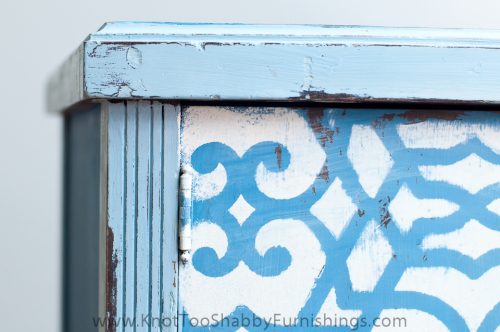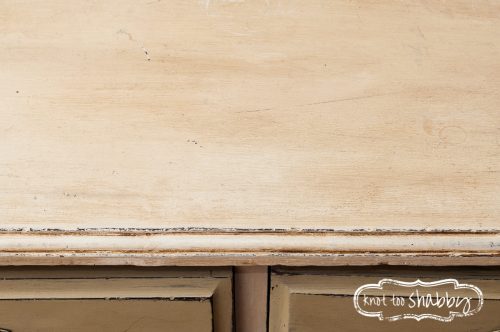
Waxing and distressing question. I normally paint, distressed then wax. I noticed many people say they distress and sand after waxing. So last night I waxed, buffed this morning and I am now distressing. The paint is already really hard and I find it harder to sand and distress but there is much less dust which I think is why people do this. Thoughts? Do you distress before or after waxing? -Jacqueline from Chicago
This is a great question and one that comes up often enough.
Let’s start by defining furniture distressing because it often gets confused with “antiquing” or “dark-waxing.”
Both distressing and waxing are techniques that can be used to replicate the patina of old furniture. Distressing is the act of wearing down the paint finish so that the substrate of the original finish peeks through. Typically, you would use sandpaper to distress a piece.

Louis Blue, Greek Blue and Pure White Chalk Paint® with the edges lightly distressed
When someone wishes to “antique,” a piece they are typically looking to add dark wax to give an aged patina that has a rich depth of color among the finish.

Lightly distressed edges WITH a dark wax finish to add an antiqued patina
So, do you distress BEFORE OR AFTER you wax?
Let’s review the Annie Sloan method!
Annie paints.
Annie waxes.
THEN Annie distresses.
Finally Annie re-waxes where she distressed.
How do I know this, you ask? First of all, I’ve been trained in the Annie Sloan method. Second of all, it’s in her book!!!

You can read all about how Annie distresses on pages 12-50 using a variety of methods
So, let’s talk about the advantages of distressing after you wax.
- It is a much cleaner process! Wax tends to hold in the dust from the sanding itself keeping an extremely limited amount of free-floating particulates in the air that would otherwise be all over the place if you distressed before you waxed.

- You have much more control over your distressing by doing it after you wax. Annie Sloan Paint is VERY EASY to work off. I’ve seen and heard of people who have distressed their pieces before they waxed and lamented that “too much paint came off.” When distressing after you wax, you can be much more intentional about taking off just the right amount of paint in the right places without over-doing it.

- You have a consistent finish when distressing after you wax. Meaning, when you distress before you apply the wax, the sand paper is not only removing paint along the edges, but also smoothing out the paint finish around the distressed area. The result is an irregular paint finish that is smooth in some places and more textured in others (as a result of brush strokes). When the wax is applied and then polished off, those distressed edges will have a higher sheen than the rest of the piece. Whereas, if you distress after you wax, the end result will be less varied.

When you distress your furniture after you apply your initial coat of wax, you don’t want to wait a day or two to do so. You will have an easier time of it if you distress immediately after you paint and wax…before the paint has had a chance to thoroughly dry and begin its curing process. Distressing AFTER you wax doesn’t have to be cumbersome or “hard.” If you wait too long to distress your piece, you will have to work much harder to remove the paint.

Now…of course, there are other ways to do it! When I teach a workshop, we talk about wet distressing, how to distress using nothing more than a wax brush and some water, the benefits of distressing with an electric sander, course sandpaper versus fine sandpaper…and so on. You will gain an appreciation for the many varied techniques simply by playing with the paint and wax and exploring the variations of how to create a multitude of looks! And, of course invest in Annie Sloan’s amazing books. I’ll tell you a secret…you can learn EVERYTHING we teach in a workshop just by reading her books. No Joke! I hold nothing back! Hit up your local thrift store, start stocking up on cheap chairs and side tables and become your own expert in the how’s and why’s of Annie Sloan Paint!